Ever landed on a website and instantly felt lost? Or maybe you were trying to buy something, but the process was so confusing you just gave up? That’s the opposite of user-friendly. A user-friendly website is one that’s easy to navigate, understand, and use. It anticipates your needs and provides a smooth, enjoyable experience. But what exactly makes a website user-friendly? Let’s break it down.
Clear and Simple Navigation
Think of a website’s navigation as a map. It should clearly show visitors where they are and how to get where they want to go. Here’s what good navigation looks like:
- Intuitive Menu: A well-organized menu that’s easy to find and understand. Use clear, descriptive labels.
- Search Functionality: A prominent search bar that allows users to quickly find specific information.
- Breadcrumbs: These show the user’s path through the site, making it easy to go back a step or two.
- Consistent Layout: Keep the layout consistent across all pages so users don’t have to re-learn how to navigate each time.
Imagine you’re on an e-commerce site looking for a specific type of shoe. A user-friendly site would have categories like “Shoes,” then subcategories like “Sneakers,” “Boots,” and “Sandals.” A clear search bar lets you type in “running shoes” and find exactly what you need.
Easy-to-Read Content
No one wants to wade through walls of text. User-friendly websites present information in a way that’s easy to digest:
- Clear Headlines and Subheadings: Break up content into smaller, manageable sections.
- Short Paragraphs: Keep paragraphs short and focused.
- Bullet Points and Lists: Use bullet points and lists to highlight key information.
- Visuals: Incorporate images, videos, and infographics to break up text and add visual interest.
- Readable Fonts: Choose fonts that are easy on the eyes and use appropriate font sizes.
Think about a recipe website. Instead of one long paragraph detailing the ingredients and instructions, a user-friendly site will use bullet points for the ingredients and numbered steps for the instructions, making it much easier to follow.
Mobile-Friendliness
With so many people browsing on their phones and tablets, a mobile-friendly website is no longer optional – it’s essential. This means the website should:
- Be Responsive: Adapt to different screen sizes and devices.
- Have Touch-Friendly Navigation: Make sure buttons and links are large enough to tap easily on a touchscreen.
- Load Quickly: Mobile users are often on slower connections, so optimize images and code for faster loading times.
Picture yourself searching for a restaurant on your phone while walking down the street. A mobile-friendly website will load quickly, display the menu clearly on your screen, and make it easy to tap the “Call” button to make a reservation.
Fast Loading Speed
People are impatient. If a website takes too long to load, they’ll likely leave. Here are some things that impact loading speed:
- Image Optimization: Use compressed images that are the right size for the web.
- Clean Code: Efficient code loads faster.
- Caching: Implement caching to store frequently accessed data.
- Content Delivery Network (CDN): Use a CDN to distribute website content across multiple servers.
Imagine trying to read a news article, but the page takes 15 seconds to load. You’d probably get frustrated and find another news source. A user-friendly website prioritizes speed to keep visitors engaged.
Accessibility
Accessibility means making your website usable for everyone, including people with disabilities. Here’s how to improve accessibility:
- Alternative Text for Images: Add descriptive alt text to images so screen readers can describe them to visually impaired users.
- Keyboard Navigation: Ensure that all website features can be accessed using a keyboard.
- Sufficient Color Contrast: Make sure there’s enough contrast between text and background colors.
- Clear Form Labels: Use clear and descriptive labels for form fields.
Think about a government website providing information about benefits. Making it accessible ensures that everyone, regardless of their abilities, can access the information they need.
Clear Calls to Action
A call to action (CTA) is an instruction to the user designed to provoke an immediate response. Make it obvious what you want visitors to do:
- Use Action-Oriented Language: Use verbs like “Buy Now,” “Sign Up,” or “Learn More.”
- Make CTAs Stand Out: Use contrasting colors and prominent placement to draw attention to CTAs.
- Be Clear and Concise: Tell users exactly what will happen when they click the CTA.
If you’re selling a product, a clear “Add to Cart” button is essential. If you want people to subscribe to your newsletter, a prominent “Sign Up Now” button will do the trick.
User Testing and Feedback
The best way to ensure your website is user-friendly is to get feedback from real users. Conduct user testing to see how people interact with your site and identify areas for improvement.
- Observe Users: Watch how people use your website and note any difficulties they encounter.
- Ask for Feedback: Ask users to provide feedback on their experience.
- Use Analytics: Track website metrics like bounce rate and time on page to identify areas that need improvement.
By watching someone try to navigate your website and listening to their feedback, you can uncover usability issues you might have missed. This iterative process of testing and improvement is key to creating a truly user-friendly website.
Creating a user-friendly website isn’t just about aesthetics; it’s about creating a positive and efficient experience for your visitors. By focusing on clear navigation, readable content, mobile-friendliness, fast loading speeds, accessibility, and clear calls to action, you can build a website that not only looks great but also delivers results.
